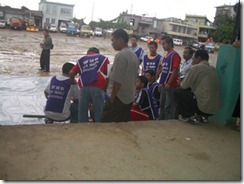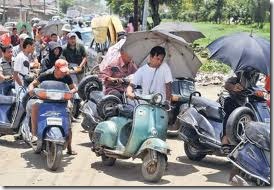By Uttara Choudhury

Boeing-C17-Globemaster. Image courtesy Boeing
New York, Sep 30 : India was the biggest buyer of conventional arms among developing nations in 2010 and had global defence giants lining up to capture $5.8 billion in new deals, said a report for the US Congress.
Worldwide arms sales in 2010 totalled $40.4 billion, a drop of 38 percent from the $65.2 billion in arms deals signed in 2009 and the lowest total since 2003, the Congressional study found.
India, which is growing its military muscle, was followed on a shopping spree last year by Taiwan, which sealed $2.7 billion in deals and Saudi Arabia which negotiated $2.2 billion in sales. Pakistan also received $2.2 billion worth of arms shipments, according to the report.
The 75-page report found that developing countries were the heaviest buyers in 2010 and the total value of arms transfer deals with developing nations last year was $30.7 billion, or 76.2 percent of worldwide deals.
The report said defence budgets in most developed countries, especially in Europe are undergoing massive cuts. In the early going of the financial crisis, defence budgets were under little pressure and indeed were often seen as part of a wider economic stimulus effort. But with the focus shifting to austerity and rebalancing books, that dynamic has changed.
As a result, developing nations continued to be the primary focus of foreign arms sales. US, Russian and European suppliers made a beeline for wealthy oil producing countries such as Saudi Arabia and the United Arab Emirates, and high-octane economies like India, China, and South Korea.
“Worldwide weapons sales declined generally in 2010 in response to the constraints created by the tenuous state of the global economy,” wrote Richard F. Grimmett, a specialist in international security at the Congressional Research Service and author of the study.
“As new arms sales have become more difficult to conclude since the global recession began, competition among sellers has become increasingly intense,” said Grimmett, noting that suppliers were sweetening deals with flashy incentives, flexible financing and co-production agreements.
The report also listed Saudi Arabia, India and China as by far the heaviest buyers over the 2003-2010 period covered in the report. Over this eight-year period, Saudi Arabia was the developing world’s top recipient of arms shipments having received some $29 billion worth of weapons, followed by India at nearly $17 billion; China at $13.2 billion; Egypt at $12.1 billion and Israel at $10.3 billion.
America and Russia have been the dominant arms sellers to developing countries over the past eight years, according to the report. Moscow actually beat out Washington in the value of arms deals it inked between 2003 and 2006, only to be overtaken by Washington over the next four years.
In actual arms deliveries to developing countries, however, Washington has dominated its competitors over the past eight years, with about $60 billion worth of transfers, compared to Russia’s $38 billion. Britain delivered $19 billion, France $12.3 billion, China $11.6 billion, Germany $6.2 billion and Israel $3.5 billion.
The report noted that India has begun to modernise its old, Soviet-era military equipment and technology and diversify its weapons supply base. “In 2008, India purchased six C130J cargo aircraft from the United States. In 2010, the United Kingdom sold India 57 Hawk jet trainers for $1 billion. In 2010, Italy also sold India 12 AW101 helicopters,” it said.
“This pattern of Indian arms purchases indicates that it is likely that Russia will face strong new competition from other major weapons suppliers for the India arms market, and it can no longer be assured that India will consistently purchase its major combat systems.”
New Delhi is aware that many of its purchases are big-ticket items so under current Indian rules, foreign companies that win orders in excess of about $62 million, must draw at least 30 percent of that order from domestic suppliers or make a similarly sized investment within India, in what is known as an offset.


















 Football fans across the nation were very disappointed as they were not able to watch some important EPL clashes, as ESPN had decided to broadcast the cash rich Champions League. At the end, it was the football fans, who lost out on the EPL action.
Football fans across the nation were very disappointed as they were not able to watch some important EPL clashes, as ESPN had decided to broadcast the cash rich Champions League. At the end, it was the football fans, who lost out on the EPL action. 



